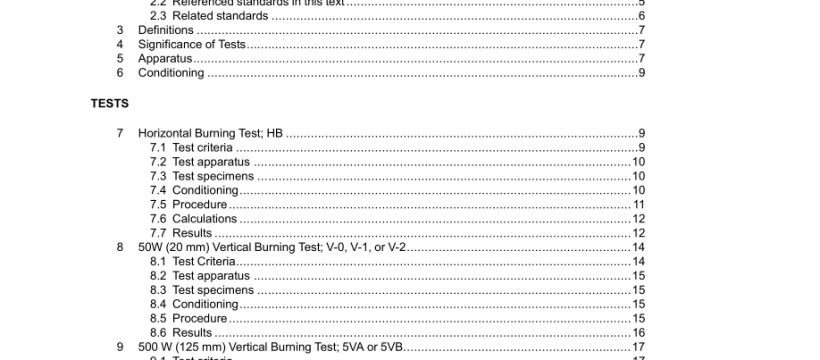UL 94-2021 pdf download.Tests for Flammability of Plastic Materials for Parts in Devices and Appliances.
5.2 Laboratory Burner – A laboratory type burner having a tube with a length of 100 ±10 mm and an inside diameter of 9.5 ±0.3 mm. The barrel is not to be equipped with an end attachment, such as a stabilizer. The burner shall be in compliance with ASTM D5025. Note: Method A of IEC TS60695-11-4 and Ignition Source P/PF2 of ISO 10093 are technically equivalent to ASTM D 5025 5.3 Burner Wing Tip – A wing tip with dimensions of slit 48 ±1 mm in length by 1.3 ±0.05 mm in width, for the burner. (Used for the test procedure in Horizontal Burning Foamed Material Test; HBF, HF-1, or HF-2… Section 12 only.) 5.4 Burner Mounting Fixture – Capable of positioning the burner at an angle of 20 degrees from the vertical axis. (Used for the test procedure in 500w Vertical Burning Test; 5VA or 5VB Section 9 only.) 5.5 Ring Stands – Laboratory ring stands with clamps or the equivalent, for horizontal or vertical positioning of the specimen and/or the wire gauze. Laboratory ring stands with clamps adjustable to the desired angles and heights, or a support gauze holder constructed from aluminum or steel, or equivalent equipment. 5.6 Timing Devices – Accurate to 0.1 second. 5.7 Measuring Scale – Graduated in mm. 5.8 Gas Supply – A supply of technical grade methane gas (min. 98 percent pure) with regulator and meter for uniform gas flow. 5.9 Wire Gauze – Having approximately 20 openings per 25 mm, made with 0.43 ±0.03 mm diameter iron or steel wire and cut to approximately 125 mm squares. (Used for the test procedure in Horizontal Burning Test; HB Section 7 only.) 5.10 Conditioning Room or Chamber – Capable of being maintained at 23 ±2°C and a relative humidity of 50 ±10 percent.
5.18 Support-Gauze – A wire cloth of plain weave, low carbon, plain steel or stainless steel, approximately 215 mm long by 75 mm wide . It is to consist of 6.4 mm mesh gauze constructed of 0.88 ±0.05 mm diameter steel wire. The cloth-mesh and wire diameter are to be determined as described in the Standard Specification for Industrial Woven Wire Cloth, ASTM E2016. (Used for the test procedure in Horizontal Burning Foamed Material Test; HBF, HF-1, or HF-2… Section 12 only.) 5.19 Foam Support Fixture – A metal support fixture capable of holding the support gauze in 5.18 including height adjustment to allow for burner height variations. See Figure 12.1. (Used for the test procedure in Horizontal Burning Foamed Material Test; HBF, HF-1, or HF-2… Section 12 only.) 5.20 Manometer/Pressure Gage – A gage capable of measuring to 200 mm of water, with increments of 5 mm. 5.21 Flow Meter – A rotameter calibrated in accordance with the Practice of Rotameter Calibration, D 3195, with correlation curves appropriate for the gas, or a mass flow meter with ±2 percent accuracy. 6 Conditioning 6.1 Specimens are to be preconditioned in accordance with ASTM D 618 (ISO 291) at 23 ±2°C and 50 ±10 percent relative humidity for a minimum of 48 hours. 6.2 Specimens for certain tests are to be preconditioned in an air-circulating oven for 168 ±2 hours at 70 ±2°C and then cooled in the desiccator for at least 4 hours at room temperature, prior to testing. 6.3 Once removed from the pre-conditioning environment, specimens shall be tested within 30 minutes. 6.4 All specimens are to be tested in a laboratory atmosphere of 15 – 35°C and ≤ 75 percent relative humidity. 6.5 Cotton shall be conditioned in the desiccator for at least 24 hours prior to use. 6.6 Once removed from the desiccator, the cotton shall be used within 30 minutes.
7.5.1 Three specimens are to be tested. Each specimen is to be marked with two lines perpendicular to the longitudinal axis of the bar, 25 ±1 mm and 100 ±1 mm from the end that is to be ignited. 7.5.2 Clamp the specimen at the end farthest from the 25 mm mark, with its longitudinal axis horizontal and its transverse axis inclined at 45 ±2 degrees. The wire gauze (see 5.9) is to be clamped horizontally beneath the specimen, with a distance of 10 ±1 mm between the lowest edge of the specimen and the gauze with the free end of the specimen even with the edge of the gauze. See Figure 7.1. 7.5.3 To produce the nominal 50 W test flame, the methane gas supply to the burner shall be adjusted to produce a gas flow rate of 105 ±5 ml/min with a back pressure less than 10 mm water and arranged as in Figure 7.3. See ASTM D 5207. NOTE: A mass flow meter is the preferred means of controlling accurately the input flow rate of gas to the burner. Other methods may be used if they can show equivalent accuracy and demonstrate that the final gas flow rate remains in the range of 105 ±5 ml/m following the test flame adjustment procedure specified in 7.5.4. 7.5.4 The burner is to be placed remote from the specimen and ignited. Adjust the burner to produce a blue flame 20 ±1 mm high. The flame is to be obtained by adjusting the gas supply and the air ports of the burner until an approximate 20 ±1 mm yellow-tipped blue flame is produced. Increase the air supply until the yellow tip disappears. Measure the height of the flame again and adjust it if necessary.UL 94-2021 pdf download.
UL 94-2021 pdf download
